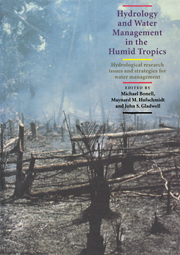 Hydrology and Water Management in the Humid Tropics
Hydrology and Water Management in the Humid Tropics Book contents
- Frontmatter
- Contents
- List of Authors
- Foreword by Federico Mayor, Director-General, UNESCO
- Preface
- Cartographic Credit
- Acknowledgements
- SECTION I INTRODUCTION
- SECTION II HUMID TROPICS SETTING
- SECTION III REGIONAL HYDROLOGY
- SECTION IV PHYSICAL PROCESSES
- 11 Recent Scientific Developments and Research Needs in Hydrological Processes of the Humid Tropics
- 12 Groundwater Systems in the Humid Tropics
- 13 Perspectives on the Hydrology and Water Resource Management of Natural Freshwater Wetlands and Lakes in the Humid Tropics
- 14 Erosion and Sedimentation
- 15 Water Quality Issues in the Humid Tropics
- 16 Ecological Characteristics of Tropical Fresh Waters: An Outline
- SECTION V PHYSICAL PROCESSES – HUMAN USES: THE INTERFACE
- SECTION VI MANAGEMENT ISSUES
- SECTION VII APPENDICES
- Place index
13 - Perspectives on the Hydrology and Water Resource Management of Natural Freshwater Wetlands and Lakes in the Humid Tropics
Published online by Cambridge University Press: 23 December 2009
- Frontmatter
- Contents
- List of Authors
- Foreword by Federico Mayor, Director-General, UNESCO
- Preface
- Cartographic Credit
- Acknowledgements
- SECTION I INTRODUCTION
- SECTION II HUMID TROPICS SETTING
- SECTION III REGIONAL HYDROLOGY
- SECTION IV PHYSICAL PROCESSES
- 11 Recent Scientific Developments and Research Needs in Hydrological Processes of the Humid Tropics
- 12 Groundwater Systems in the Humid Tropics
- 13 Perspectives on the Hydrology and Water Resource Management of Natural Freshwater Wetlands and Lakes in the Humid Tropics
- 14 Erosion and Sedimentation
- 15 Water Quality Issues in the Humid Tropics
- 16 Ecological Characteristics of Tropical Fresh Waters: An Outline
- SECTION V PHYSICAL PROCESSES – HUMAN USES: THE INTERFACE
- SECTION VI MANAGEMENT ISSUES
- SECTION VII APPENDICES
- Place index
Summary
ABSTRACT
A review is presented of the hydrology and water resource values of humid tropical wetlands and lakes. Issues discussed in relation to natural lakes are long-term changes in water levels, aquatic weeds and modelling lake/river interactions. The status of tropical wetland research is presented with reviews of different modelling strategies, empirical water balance studies, and wetland influences upon downstream flows. Current issues involving wetlands in the water resource arena are discussed, and strategies for optimal wetland management and research strategies are identified.
INTRODUCTION
Wetlands occupy approximately 6% of the earth's land surface, and can be found on each of the tropical continents. Table 1 illustrates that tropical wetlands are most extensive in South America, with similar areal extents between Asia and Africa. Balek (1977) reports that the 340 000 km2 of wetlands within Africa are composed of some 104 to 105 individual wetland systems alone. Table 2 illustrates that wetlands can cover up to 10% of individual countries on the African continent and up to 30% on the Asian continent. Early estimates of wetland proportions in the tropics are being revised upwards as improved surveys are carried out in more isolated regions of the world (Maltby, 1988). Furthermore, consideration of wetland extent in the past has tended to under-represent the number of small seasonal wetlands, such as the dambo, pan and black clay types (Howard-Williams & Thompson, 1985), which can occupy over 25% of the land surface areas in many regions of southern Africa.
- Type
- Chapter
- Information
- Hydrology and Water Management in the Humid TropicsHydrological Research Issues and Strategies for Water Management, pp. 273 - 300Publisher: Cambridge University PressPrint publication year: 1993
- 2
- Cited by


